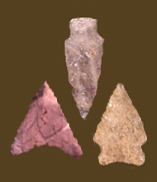
|
LEVANNA
Chronology The Levanna point dates to the late Middle Woodland and Late Woodland periods. Justice (1987) suggests a range of 600 to 1200 AD. Ritchie (1971) places it between 700 and 1350 AD, when it begins to be replaced by the Madison point. He notes that it does not become common in New York until after 900 AD. Steponaitis (1980) suggests the Levanna dates between 800 and 1250 AD, while Kinsey (1972) places it between 900 and 1350 AD. Description Blade: The blade is triangular and broad. Most of the points are nearly equilateral, but some are isosceles. The edges are usually straight, but can be incurvate or excurvate. Haft Element: The base is usually concave, in some examples deeply so, but straight bases do occur. Basal grinding is sometimes present. Size: Length ranges from 22 to 75 mm, with an average of 38 mm. Width ranges from 24 to 36 mm, with an average of 29 mm. Thickness ranges from 4 to 8 mm, with an average of 5 mm. Technique of manufacture: Pressure flaking; flake scars are small, narrow, and well-controlled. Material: In a sample of 40 Levanna points from the lower Patuxent drainage, Steponaitis (1980) reported that 42% were quartz, followed by chert (21%), quartzite (21%), rhyolite (8%), jasper (5%), and argillite (3%). In the area surrounding Zekiah Swamp on the lower Potomac, Wanser (1982) found that 81% of 58 Levanna points were quartz, with 7% quartzite, 7% chert, 3% rhyolite, and 2% jasper. In the Monocacy River drainage, 63% of 595 Levannas were rhyolite, with 18% quartz, 7% quartzite, 7% chert, 3% jasper, and 2% argillite (Kavanagh 1982). Rhyolite, chert, jasper, quartzite, and quartz are used for Levanna points in the middle Potomac River Valley (Hranicky 2002). In the Hagerstown Valley, over half of the triangular points were rhyolite, followed by lesser amounts of chert, jasper, quartz, and quartzite (Stewart 1980). In Delaware, triangular points are most commonly made from quartz, jasper, and chert (Custer 1996a). Discussion As a general rule of thumb in Maryland, large Late Woodland period equilateral points can be classified as Levanna, small equilaterals as Potomac, and isosceles points as Madison. However, the published type descriptions for all three show considerable morphological overlap. As a result of this, and given also the potential modification of triangular points through resharpening, the assignment of type names and dates to individual specimens can be problematic. Some researchers prefer to combine all the Late Woodland triangular points into one type (cf. Custer 1996a; Wall et al. 1996). Defined in Literature Other Names Used References |
![]()
Search by Shape:
(See Projectile Point Typology) |

|
Thank you for visiting our website. If you have any
questions, comments, Copyright © 2002 by |

|

 Defining Attributes
Defining Attributes